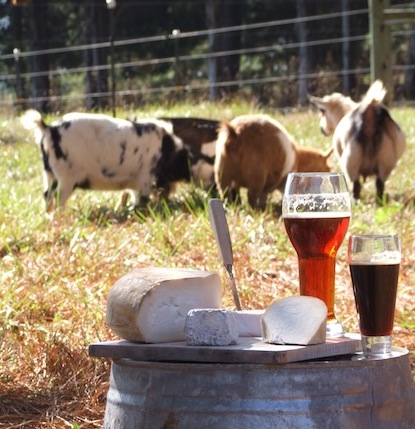When Cindy West left a career in accounting, she and her husband Dorian spent a year in Paris, where she trained as a chef. Back in her home state of North Carolina, she worked in restaurants until the demanding schedule of a professional chef collided with the needs of young children. The couple bought a farm in Hillsborough, Cindy threw herself into a new self-taught craft, and in time they decided to take their dream and “go pro.” The Wests bought tanks and equipment and turned the old tobacco farm over to the production of…
Over the past four decades, consumer frustration with national brands and styles has transformed wine, beer, coffee, chocolate—and now, cheese.
Beer lovers will know a score of stories where this sentence finishes with the word “beer.” The modern revolution in American brewing has been propelled by people like the Wests, who turned away from established careers to carve out a new life in craft brewing. But the West’s narrative is completed with the word “cheese” instead. They opened Hillsborough Cheese Co., where they make a small range of cheeses only available locally. The Wests are kindred spirits to any upstart microbrewers of the last decade.

(Patrick Morrison)
The parallels between beer and cheese are striking: their histories both start with a varied, home-based industry with strong ties to indigenous producers; the industrial age consolidated manufacturing in the hands of a smaller number of national companies; local styles and businesses lost ground to the ubiquity of a few inoffensive styles; and traditional approaches have recently made a comeback, thanks to a combination of multi-generational regional producers and newly-recruited innovators.
The world of new American cheese even includes traditionalist revival producers (think Anchor Brewing) and what might be called “extreme” cheese makers (think Dogfish Head). There are debates about authenticity: where beer people argue about who can and cannot wear the badge “craft,” cheese makers struggle over the divide between “specialty” and “artisanal.”
We are eating three times the amount of cheese we ate in 1970, according to educator and writer Max McCalman, author of the newly published Mastering Cheese: Lessons for Connoisseurship from a Maître Fromager. “As in craft brewing,” he explains, “less of the enthusiasm is for the processed cheese or the industrial style of beer. There is a growing connoisseurship for fine cheeses.” The steepest growth in cheese appreciation has come in the last decade.
For both beer and cheese, the passion of a small number of producers and consumers has made life at the table more flavorful for all of us.
Prehistoric Sustenance
The similarities between beer and cheese go back to basic biology, and to their origins millennia ago.
One of the fundamental advances in human history had to do with the ability to preserve food, extending a bridge of security that would let communities transform today’s plenty into sustenance for the lean seasons. Today’s fresh kill is next winter’s cured meat. The summer’s abundant fruit becomes wine. The grain harvest can be saved as beer, and surplus fragile milk becomes long-lasting cheese. A predictable diet could give our species the assurance to extend its reach into otherwise hostile lands. Our ability to modify food is part of what makes us human.
Beer and cheese were both lucky accidents of some 3- or 4,000 years ago, and both probably required that a level of basic technology already be in place. Since grain has to be germinated or baked to make its sugars available for fermentation, it’s likely that early beer arose from the accidental soaking of primitive bread. The first brewers had to already be bakers.
And cheese, which is essentially the controlled spoilage of milk, first required that animals be domesticated for milking. Domestic herds gave milk, meat and materials: a slaughtered animal’s organs made convenient containers. Fresh milk stored in the stomach of a young animal would have separated naturally through the actions of the stomach’s enzymes into curds and whey: simple cheese.
Beer and cheese share an additional attribute: both made the unpalatable safe for consumption. The boiling that was part of brewing killed pathogens and turned unhealthy water into a wholesome beverage. And cheese making converted milk, a food most humans cannot digest after infancy, into a food that could sustain adults who had become “lactose intolerant”—the norm for most of the human family.
The Power of Fermentation
Beer and cheese have changed in the past four millennia, but neither has strayed very far from its origins.
Both owe their character to the transforming power of microorganisms: fermentation. In brewing, simple sugars from grain are converted by yeast into alcohol and carbon dioxide. Cheese making depends on the conversion of milk by a bacterial culture that makes it acidic, turning the milk sugar lactose into lactic acid. Then rennet, a digestive enzyme complex from the stomach of an unweaned ruminant animal, curdles the milk, turning it into a solid mass. In essence, casein, the chief protein in milk, is partially digested by the rennet into a solid (curds) and a liquid (whey). (There are now vegetable rennets, also.)
Beyond the process of fermentation, the art of brewing consists of the selection and handling of the grains (barley, wheat, oats, rye, rice among others), the addition of other flavors (primarily hops, but also other spices and fruits), and the careful conditioning of the beer.
Similar choices turn the cheese maker into an artist. Milk from cows, sheep and goats are the most popular selections, though water buffalo, yak, camel, reindeer and mares’ milk have been made into cheese. The cheese maker can also select additional flavoring agents: secondary microbial cultures of mold or bacteria that will ripen the cheese into familiar varieties such as Roquefort or Camembert, as well as fruits and spices. And, lastly, cheeses can be aged under different regimes for weeks or years to attain desired qualities.










